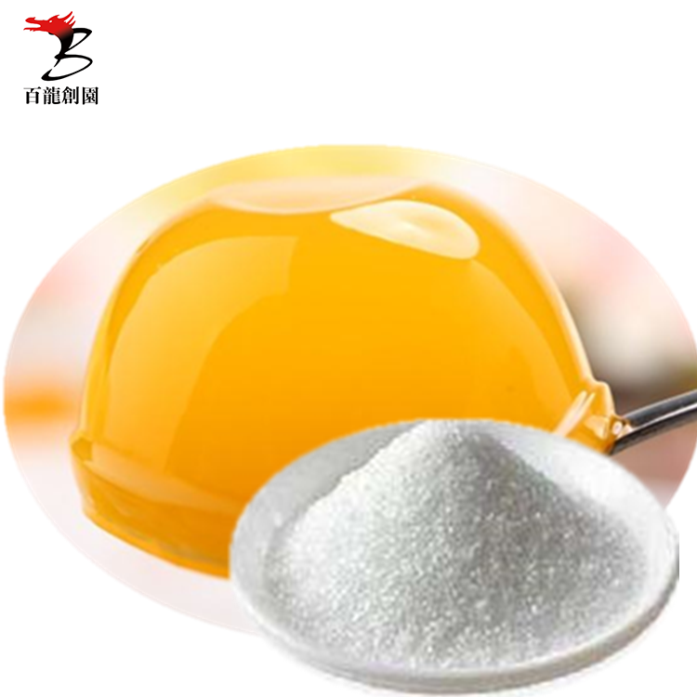b

Thank You!
Your requirement has been sent, we will contact you quickly!
Sent Failed!
Try again!
Product Introduction:
Isomaltulose is a disaccharide carbohydrate composed of glucose and fructose. Glucose and fructose pass through α- 1,6-glycosidic bond (chemical name: 6-0)- α- D-glucopyranosyl-d-fructose) linkage. Isomaltulose is present in honey and sugarcane extracts. Its taste is similar to sucrose, but its sweetness is halved. Isomaltulose, also known as palaginose, is produced by enzymatic rearrangement (isomerization) of sucrose in beet sugar This enzyme and its physiological properties were widely studied in Germany in 1950. Isomaltulose has been used as a sugar substitute in food in Japan since 1985 and in the European Union since 2005. The United States since 2006, Australia and New Zealand since 2007, in addition to other countries in the world. For example, the Codex Alimentarius provides analytical methods for the characterization and determination of commercial isomaltulose. Its physical properties are very similar to sucrose, which makes it easy to use in existing formulas and processes.
Isomaltulose is hydrogenated to produce isomaltulol, a highly digestible carbohydrate used as a sugar substitute, such as in sugar free candy and candy.
The sweetness is 42% of sucrose. Its sweet taste is similar to that of sucrose. Isomaltulose is not hygroscopic. Strong acid hydrolysis resistance. The thermal stability is slightly worse than that of sucrose and is not fermented by most bacteria and yeast. Mask the odor and balance the taste and flavor. When heated at high temperature for a long time, it is slightly easier to color than sucrose.
Regulatory permission
China: food additives
United States: FDA certified gras food
Europe: allowed in food
ANZ Latin America: allowed to be added to food
EU: new resource food

Product sensory requirements
project | Require |
color | White |
condition | Crystalline uniform granules or powder |
taste | sweet |
Quality specification standard GB 1886.182-2016
project | index |
Isomaltulose content (dry basis), w/% ≥ | 98.0 |
Other sugar content (on dry basis), w/% ≤ | 2.0 |
Drying loss, w/% ≤ | 1.0 |
Ash, w/% ≤ | 0.1 |
Lead (Pb)/(mg/kg) ≤ | 0.5 |
Total arsenic (as As)/(mg/kg) ≤ | 0.5 |
Applications
Product Category | Quality improvement | Recommended dosage g/100g |
Dairy products (infant formula powder) | Improve mouthfeel, optimize texture, enhance stability | 15-25 |
drinks | Improves mouthfeel, enhances stability, increases solids content | 3.5-6 |
candy | Improve taste, enhance stability, release energy | - |
baked goods | Optimized color, enhanced stability, reduced heat | 9-15 |
health products | Improve taste | 2-20 |
cold drink | Improve gloss and mouthfeel | -- |
Application:
In terms of nutrition, isomaltulose is a food energy source, providing the same energy as sucrose. Like sucrose, isomaltulose provides sweetness for food, but the sweetness of isomaltulose is only about half that of sucrose. Isomaltulose and sucrose have similar characteristics in food preparation and processing. Recipes that allow the use of sucrose can replace or use isomaltulose together.
Isomaltulose is used in food, beverage and health products because of its many characteristics. It is used in foods and beverages to provide natural sweetness similar to sucrose. Its sweetness ability is about half that of sucrose, and there is no aftertaste. It has extremely low hygroscopicity (hygroscopicity), which makes it have the characteristics of instant free flow. Because of their low risk of caking, it can be easily used in beverages and other instant products. It is highly stable during processing, including acidic conditions and the environment in which bacteria may grow. For example, in sports drinks, isotonic properties (osmotic pressure equal to the osmotic pressure of the liquid in the body) can be maintained during storage during the shelf life of the beverage.
Isomaltulose can be used in baked goods, pastry glazing and icing, breakfast cereals, cereal bars, dairy products, candy (such as chocolate, jelly, chewy candy and gum or bubble gum), frozen desserts, fruit juice drinks, malt drinks, sports drinks, energy drinks, instant drinks, and special and clinical nutritional feeds.
Isomaltulose is allowed to be used in food and beverages in many parts of the world. For example, it is generally considered safe by the U.S. Food and Drug Administration (GRAS), approved as a new food by the European Commission, and has the status of FOSHU (specific health food) in Japan.
Certification:
At present, ours products have passed international BRC certification, US FDA certification, international ISO series certification, IP non-GMO certification, HALAL certification, KOSHER certification, ORGANIC EU/US organic certification, Japanese organic certification, domestic organic certification.

Factory:
Bailong Chuangyuan is a high-tech enterprise integrating production, learning and research with bioengineering as its leading industry. The company has a production line with a high degree of automation and advanced equipment. The production workshop is built in strict accordance with GMP standards, from raw material feeding to product filling. The equipment is fully automated to ensure the stable production process, technology and product quality.

FAQ:
Q1: Can we get some sample for testing before purchasing?
A1:Yes, 20~100g free sample is available, but freight charges will be at customer's account, and then freight charges will be returned or deduct from the future order, or the sample can be sent by your express account.
Q2:Which kind of payment do you accept?
A2:1. For small order, you can pay by Paypal, Western Union or MoneyGram, or through Alibaba.
2. Normal order by T/T.
Q3:How do you ship the cargo to us?
A3: By DHL Express, By Air, By Sea or negotiation.
Q4. How about the packing?
Usually we provide the packing as 25 kg / bag or carton. Of course, if you have special requirements on them, we will according to you.
Q5. How about the validity of the products?
Actually, it according to the products you ordered.
Q6. What documents you provide?
Usually, we provide Commerical Invoice, Packing List, Bill of loading, COA , Health certificate and Origin certificate.

